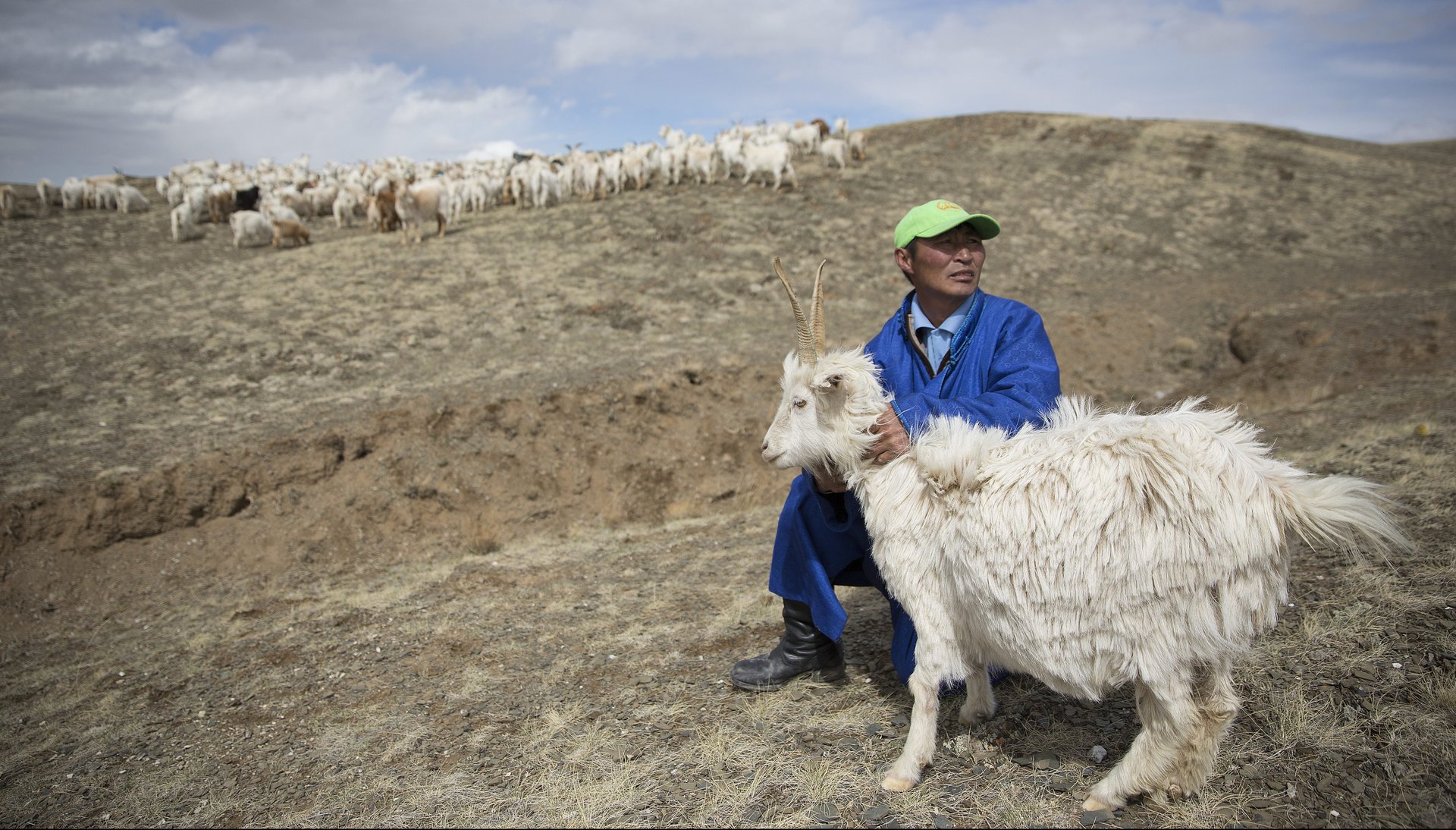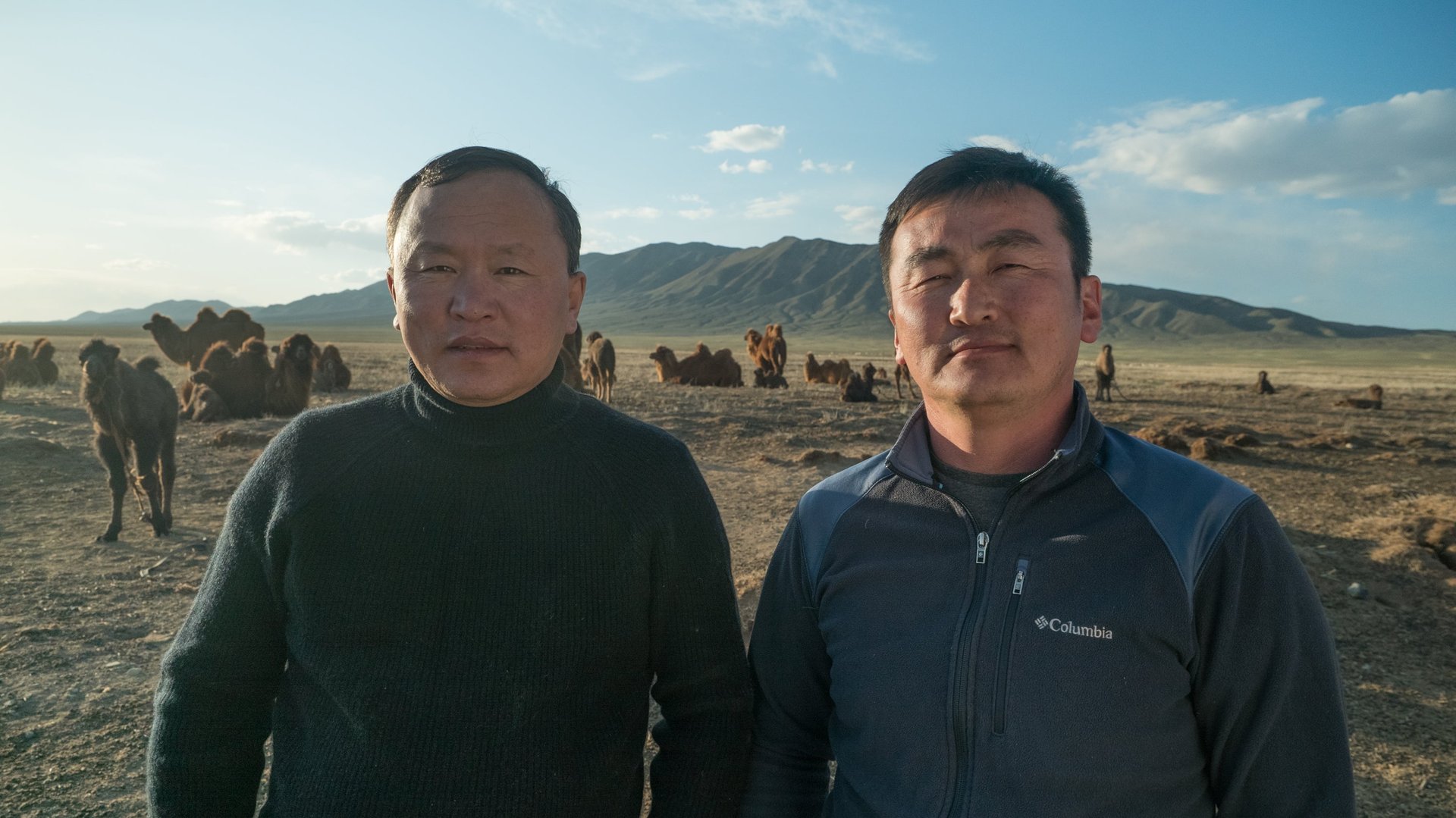The new marker of luxury is feel-good storytelling
How does a cashmere brand stand out in the age of $80 cashmere sweaters?


How does a cashmere brand stand out in the age of $80 cashmere sweaters?
Quality itself isn’t enough these days. The cashmere from the young label Naadam may be nicer than what you’ll find for lower prices at Uniqlo or J.Crew, but identifying good cashmere is hard, unless you really know what to look for. And the brand’s crewnecks aren’t so distinctive that their design makes them stand out from the crowd.
What really makes the company’s cashmere stand apart is its story. It’s a crazy tale—we’ll get to it shortly—and usually one of the first things you’ll read about the brand. Just as important, it connects Naadam’s customers to the people who make the products they’re buying.
That connection increasingly matters to shoppers. Our clothes and other personal goods might seem as if they spontaneously materialize on store racks, but customers are becoming increasingly and uncomfortably aware that the items we purchase are the end result of an obscure, sprawling global supply chain. Some brands have started to differentiate themselves by touting their supply chain “transparency,” even if it doesn’t always ensure their products are sustainably made by workers who are paid and treated fairly.
A growing handful of online brands are taking this model another step. They’re cutting links from that global supply chain, selling from the source straight to consumers and making sure the story gets told. That story might feature Mongolian goat herders—as Naadam’s does—or the artisans in Morocco who weave traditional rugs on the website The Anou. It could be Ethiopian textile weavers who help create the chic clothes at Cienne NY. Or it could be Italian craftspeople producing traditional luxury goods, including those on the artisan marketplace Rossi & Rei, or the shoe brand M. Gemi. Update: Since publication of this story, Rossi & Rei has been renamed Milaner.
The point is that the brands believe this information matters, and that in addition to the usual traits of quality and good value, their customers also crave an emotional connection in what they’re buying.
Mongolian goat herders’ star turn
Naadam’s origin story—documented in a zany YouTube video—finds two of the brand’s founders, Matt Scanlan and Diederik Rijsemus, tearing across the Gobi Desert in Mongolia in a small truck filled with about $2.5 million in cash. It was 2015, and they were on their way to buy all the cashmere they could. It turned out to be about 60 tons worth.
Scanlan had first traveled to Mongolia three years earlier, after quitting a Wall Street job in New York. He had gone to meet up with his college friend Rijsemus, who was there for an internship studying emerging markets. In Ulaanbaatar, the capital, Scanlan and Rijsemus met two locals, and ended up traveling with them to their home far into the Gobi, not realizing they would be stuck there for a month. It gave them the opportunity, however, to learn how their hosts made a living herding goats that produce cashmere.

Mongolia is known for having some of the finest cashmere in the world. But while shoppers in the US and Europe pay high prices for it, the herders at the other end of the supply chain are often being squeezed. That’s because once cashmere comes off the goat, it typically passes through a chain of middlemen, each one turning a profit and raising the price as they pass it to the next set of hands. To keep prices down, cashmere traders buy from the herders as cheaply as possible.
Scanlan and Rijsemus returned to Mongolia in 2015 with all the cash they could raise because their plan was to buy the cashmere from the herders directly, knit it into sweaters, and sell them in the West, sharing a higher percentage of the profits with the herders. They found someone back home who could design clothing: the company’s creative director and other cofounder, Hadas Saar. Naadam is the result. (The name is taken from a Mongolian festival.)
“I think it’s the most important thing we do,” Scanlan says, of telling the story of why the brand exists. “Speaking directly with our customers, having a direct conversation with them, was always going to be the best way to communicate the value of what we’re doing.”
The company says it pays the herders 50% more than traditional traders do. Because the company sells direct-to-consumer, skipping all the markups added by middlemen and a wholesale model, it says it can offer some of the highest-quality cashmere around for an affordable price. A sweater generally runs just over $200. Many other products, such as lightweight cotton-cashmere t-shirts, sell for less.
Just as valuable to Naadam’s customers, Scanlan says, is that feeling of connection to people in a remote and rural region, the ones who raised the goats whose wool they wear. ”I think people want to be connected to the things they own,” he says. “In a globalized economy like the one we have, it’s really hard to feel like we know where any of the things we have in our lives come from.”
Putting a face on Italian craftsmanship
When Elisa Rossi talks about her company, Rossi & Rei, she echoes several things Scanlan said. ”I think this is something that women nowadays crave, the sense of connectedness with the things they buy, knowing the story behind it,” she says.
Rossi & Rei is still just getting off the ground, but it aims to be a marketplace that connects shoppers with Italy’s wealth of artisans. The country, of course, is where the world’s most prestigious luxury brands produce many of their goods—but sometimes now that’s in Chinese-owned factories where sweatshop-like conditions prevail.
A former tech worker, Rossi had long thought of finding a way to connect shoppers to the artisans she saw growing up in Italy, so she created Rossi & Rei, where she tries to emphasize who made the product as much as the product itself.
“That’s something that a lot of brands are reluctant to do, because they don’t want to share their supply chain with the rest of the world,” she says. Luxury brands in particular often try to keep their suppliers secret or use deceptive practices. They may produce most of a pair of heels in one country, for example, and then “finish” them in Italy or France, allowing them to say on the label that’s where the heels were made. They might also keep their Italian factories to themselves to retain a competitive advantage. Either way, the people who make the products remain unknown.
“You never know their story,” she says. “And I always thought it was a shame, because their stories are quite spectacular.” That’s why, Rossi says, “we’re showing videos, so you see the faces of the people.”
The plan is to allow shoppers to buy products customized to their size and preferences directly from these makers. Right now there are only three artisans working with the site, but Rossi says they will expand to include many more, as well as more products per artisan.
One group, Maglificio Tomas, is a family business that produces exquisite knitwear. It was founded in 1974 by a husband and wife, Piero and Maria Pia Tomassini. Maria started learning to knit at the age of 12, on a hand-operated machine. Not tall enough to use it, she had to stand on a fruit crate. Over the years her skills grew, and her husband felt so strongly about her talent that he convinced her to open a shop. Today their daughter, Mara, runs the business.
Rossi herself grew up in a small town in Italy called Porto Sant’Elpidio, known as a hub of high-end shoe manufacturing. ”Growing up, I would see artisan workshops everywhere selling luxury shoes,” she explains. “I could go in, I could meet the artisans, sit down, pick the leather, pick the type of shoe that I wanted, have everything customized to my preferences, to my size.”
Shoemakers you can see
These storytelling brands tend to work on a direct-to-consumer model for a few different reasons. One is because it’s easy. E-commerce lets you make a product and put it up for sale without needing any retail relationships to get into stores.
It’s also about price. These brands can skip the normal markup that comes with selling via a retailer, who usually marks it up to twice the wholesale price it paid in order to make a profit. This model lets these new wave companies charge accessible prices for better-quality goods. It’s the system brands such as Everlane and Warby Parker helped popularize.
M. Gemi, which sells high-end shoes made by family-owned Italian factories, places less emphasis on the makers behind its products than Naadam or Rossi & Rei. But they’re still a key ingredient in the brand’s appeal and marketing, since it’s premised on offering Italian craftsmanship at accessible prices. Its founder, Maria Gangemi, grew up in Italy amid luxury artisans, like Rossi.
Just as importantly, these brands tend to argue that selling directly to consumers lets them pay the artisans making the products more than they would normally receive when they manufacture products for big labels that sell wholesale. Scanlan calls it “millennialist capitalism.”
“The ultimate goal was to rig this decades-old trading system to favor the base of the supply chain, while also making a profit,” he wrote in a 2016 essay for Fortune. The brand Cienne NY operates on a similar ideal.
It makes sense. Every layer of buyers and sellers between the customer and its maker increases the price and reduces the supply chain’s transparency. And if you’re seeking a connection to a Mongolian herder, a Bolivian textile weaver, or an Italian shoemaker, the fewer layers between you and them the better.